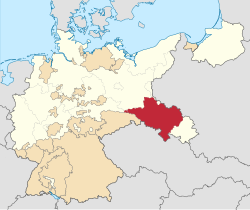| Provincia de Baja Silesia Provinz Niederschlesien | |||||||||||||||||||||||||||||||||||||||||||
|---|---|---|---|---|---|---|---|---|---|---|---|---|---|---|---|---|---|---|---|---|---|---|---|---|---|---|---|---|---|---|---|---|---|---|---|---|---|---|---|---|---|---|---|
| Provincia prusiana [1] | |||||||||||||||||||||||||||||||||||||||||||
|
1919-1938 1941-1945 | |||||||||||||||||||||||||||||||||||||||||||
| |||||||||||||||||||||||||||||||||||||||||||
 Baja Silesia (en rojo) como provincia del Estado Libre de Prusia (amarillo), dentro de la República de Weimar. | |||||||||||||||||||||||||||||||||||||||||||
| Coordenadas | 51°06′39″N 17°02′51″E / 51.110833333333, 17.047611111111 | ||||||||||||||||||||||||||||||||||||||||||
| Capital | Breslau | ||||||||||||||||||||||||||||||||||||||||||
| Entidad | Provincia prusiana [1] | ||||||||||||||||||||||||||||||||||||||||||
| Superficie | |||||||||||||||||||||||||||||||||||||||||||
| • Total | 26 981,33 km² | ||||||||||||||||||||||||||||||||||||||||||
| Población (1941) | |||||||||||||||||||||||||||||||||||||||||||
| • Total | 3 286 539 hab. | ||||||||||||||||||||||||||||||||||||||||||
| • Densidad | 121,81 hab/km² | ||||||||||||||||||||||||||||||||||||||||||
| Período histórico | Edad Contemporánea | ||||||||||||||||||||||||||||||||||||||||||
| • 1919 | Tratado de Londres | ||||||||||||||||||||||||||||||||||||||||||
| • 7 de mayo de 1946 | Segundo Tratado de Londres | ||||||||||||||||||||||||||||||||||||||||||
| Miembro de | República de Weimar, Alemania nazi | ||||||||||||||||||||||||||||||||||||||||||
| |||||||||||||||||||||||||||||||||||||||||||
| |||||||||||||||||||||||||||||||||||||||||||
La Provincia de Baja Silesia (del alemán: Provinz Niederschlesien) fue una provincia del Estado Libre de Prusia desde 1919 hasta 1945. Entre 1938 y 1941 fue reunificada con Alta Silesia como provincia de Silesia. La capital de Baja Silesia era Breslavia (ahora Wrocław en Polonia). La provincia fue dividida en dos regiones administrativas (Regierungsbezirke), Breslavia y Liegnitz.[1]
La provincia no era congruente con la región histórica de Baja Silesia, que ahora permanece principalmente en Polonia. Adicionalmente comprendía los distritos de la Alta Lusacia de Görlitz, Rothenburg y Hoyerswerda en el oeste, que hasta 1815 habían pertenecido al reino de Sajonia, así como el anterior condado de Kladsko en el sureste.
La provincia desapareció al final de la II Guerra Mundial y con la implementación de la Línea Óder-Neisse en 1945, el área al este del río Neisse pasó a la República de Polonia. La parte occidental, menor, fue incorporada a los estados alemanes de Sajonia y Brandeburgo.
Regiones administrativas[2]
Regierungsbezirk Breslau
Distritos urbanos / Stadtkreise
- Ciudad de Breslavia
- Ciudad de Brieg
- Ciudad de Schweidnitz
- Ciudad de Waldenburg
Distritos rurales / Landkreise
- Landkreis Breslavia
- Landkreis Brieg
- Landkreis Frankenstein
- Landkreis Glatz
- Landkreis Groß Wartenberg
- Landkreis Guhrau
- Landkreis Habelschwerdt
- Landkreis Militsch
- Landkreis Namslau
- Landkreis Neumarkt
- Landkreis Oels
- Landkreis Ohlau
- Landkreis Reichenbach (im Eulengebirge)
- Landkreis Schweidnitz
- Landkreis Strehlen
- Landkreis Trebnitz
- Landkreis Waldenburg
- Landkreis Wohlau
Regierungsbezirk Liegnitz


Distritos urbanos / Stadtkreise
- Ciudad de Glogau
- Ciudad de Görlitz
- Ciudad de Hirschberg im Riesengebirge
- Ciudad de Liegnitz
Distritos rurales / Landkreise
- Landkreis Bunzlau
- Landkreis Fraustadt
- Landkreis Freystadt i. Niederschles.
- Landkreis Glogau
- Landkreis Görlitz
- Landkreis Goldberg
- Landkreis Grünberg
- Landkreis Hirschberg
- Landkreis Hoyerswerda
- Landkreis Jauer
- Landkreis Landeshut
- Landkreis Lauban
- Landkreis Liegnitz
- Landkreis Löwenberg
- Landkreis Lüben
- Landkreis Rothenburg (Ob. Laus.)
- Landkreis Sprottau
Véase también
Referencias
- ↑ http://www.deutsche-schutzgebiete.de/provinz_schlesien.htm Division of Siliesia Province
- ↑ http://www.genealogienetz.de/reg/SCI/index.html Administrative divisions of Lower and Upper Silesia (en alemán)










